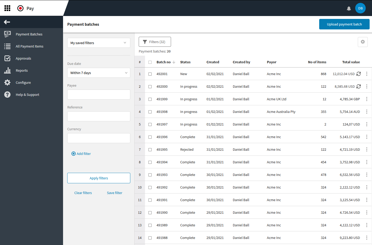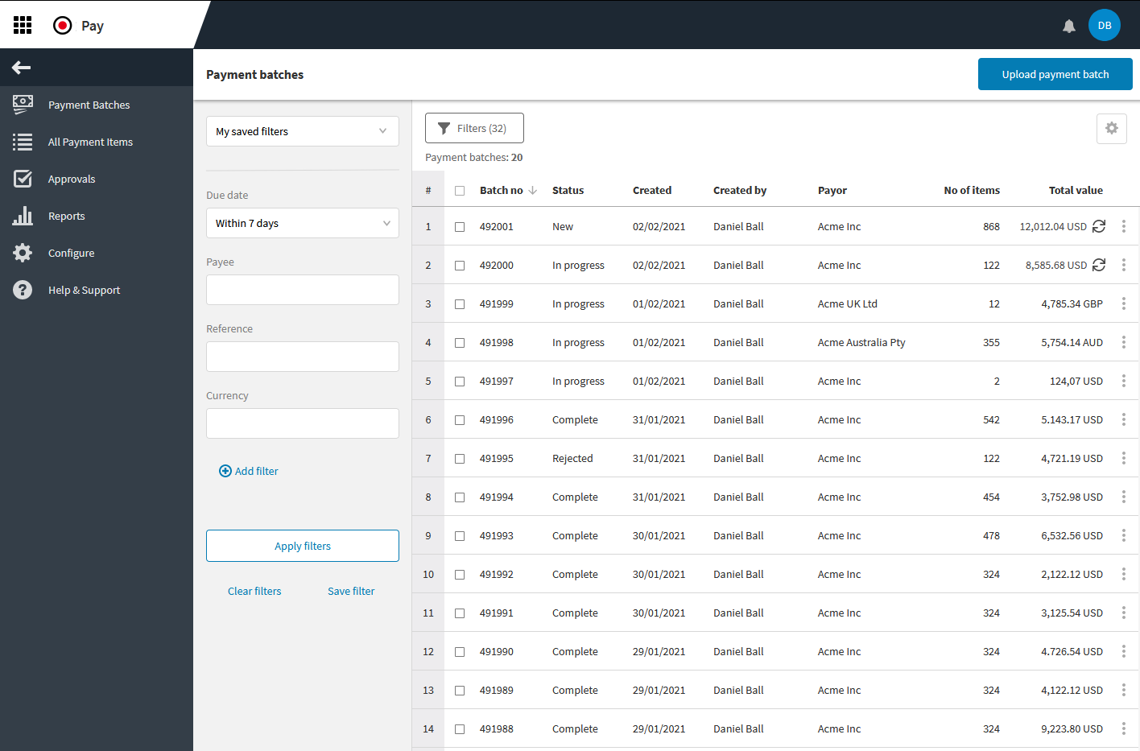

What is batch payment processing?
A batch payment is a grouping of payments that are paid out from the same bank account. Companies may choose to process these group payments manually or through automated means.
Companies that rely on manual payment processing methods face increasingly difficult issues.
Time marches on, and the world around us – including customers, suppliers, and business partners – increasingly relies on electronic invoicing and payment methods. Businesses that fail to keep up with the times will find that their processes slow to a crawl.
Another factor that plagues companies is the complexity of doing business as they scale up. Over time, a company will increase its throughput, which means an ever-larger number of items that must be processed for payment.
These are just a couple of reasons that most companies are looking for ways to expand their AP automation methods.
One study by PYMENTS showed that 98% of surveyed business leaders believed automation techniques like batch processing of payments would improve their speed of doing business.
Source: “The Data Point: 98% of Businesses Say Automated AP Speeds Payables, Fuels Growth.” Pymnts.com, PYMNTS, 24 May 2022.
Benefits of batch payment processing
AP teams will benefit from switching to an automated batch payment process.
Consider some valuable changes driving this move to a more stable workflow.

Time efficient
Manual workflows equate to a need for a standard payment timeline. AP teams are hands-on and must manage the process manually, which takes as long as it takes.
An automated AP solution creates a consistent, streamlined timeline for the process. This simplification leads to a more structured AP environment and strengthens vendor relationships with on-time payments.
Cost effective
Time is money. A single bulk transaction reduces the number of individual transactions on banking statements that must be reconciled.
Automation techniques allow AP professionals to process more payments as the company grows, without the need for additional headcount.


Fewer errors
Errors like duplicate payments create additional work and cost for AP staff. Repetitive data entry can allow mistakes or even fraud to creep in.
An automation platform introduces safeguards such as dual authorizations, role-based access, and flagging duplicate invoices. This reduces human error and improves security.
Easier tracking
Automated payments supported by electronic documentation (e.g., invoices, proof of delivery) are easy to track and reconcile.
Digitized data allows AP departments to generate reports and dashboards that provide visibility into cash flow, payment status, and vendor metrics.


Predictable cash flow
Batch payment processing allows businesses to schedule payments in advance and manage their cash outflow more predictably, aligning disbursements with available cash reserves.
Stronger vendor relationships
Vendors appreciate reliable, consistent payments. Batch processing helps maintain these relationships by reducing late payments and minimizing errors.

Best practices when batch payment processing
Automated batch payment processing follows a standard progression of steps:
Invoices are received and approved.
A payment is created for each invoice and approved for release.
An AP automation platform creates a batch to consolidate many payments into one.
The platform facilitates vendor payments using multiple payment methods: ACH, SEPA, BACS, CHAPS, BankGiro, wire, checks, and virtual cards.
To ensure this process runs smoothly, AP teams should prioritize:
Digitizing all incoming invoices and associated documentation
Enforcing invoice approval workflows with audit trails
Segmenting batch payments by geography or priority
Scheduling recurring payment batches for predictability
Integrating with the ERP for GL reconciliation
Medius provides tools that address every step of the invoice-to-pay workflow.
Unlock the future of payments automation
Manual payments are costly, slow, and risky. The eBook “The future of payments automation for global businesses” shows how leading finance teams cut costs, gain real-time visibility, and prevent fraud with AI-powered automation designed to handle the complexity of multinational organizations. Discover the features to look for in a global payment provider — and how to future-proof your finance function.
Manual vs. automated batch payment processing
Manual
Manual processes cost more time and money, especially when managing multiple payment types and approval steps.
Paper checks require physical handling. ACH may need banking intervention. Journal entries and reconciliations must be done line by line. This process repeats every cycle and increases staffing needs as the business grows.
Automated
Automated batch payments, as part of broader AP automation, simplify the workflow.
The result is:
- A standard payment timeline
- Enhanced security
- More accurate reconciliation
- Fewer human touchpoints
- Improved vendor satisfaction
According to Ardent Partners' 2025 research, 68.5% of all payments are now made electronically. Paper checks are in decline.
Source: Ardent Partners' State of ePayables 2025: AP’s Unfinished Journey
Common use cases for batch payment processing
Payroll processing
Grouping salaries for disbursement on paydays.
End-of-month reconciliation
Processing accumulated vendor invoices in bulk.
Vendor payments
Paying multiple suppliers in a coordinated payout cycle.
International payments
Streamlining cross-border payouts.
Subscription/automated billing
Handling large volumes of recurring invoices.
How AP Automation supports batch payment processing
AP automation platforms streamline the batch payment process for high-volume businesses in several ways:
- Invoice ingestion from email, EDI, or portals into a central platform
- Approval workflows tailored by business rules, amounts, and roles
- Batch payment creation based on due dates, vendor terms, and payment type
- ERP integration to sync payment status and ensure financial accuracy
- Security protocols like segregation of duties and audit trails
- Real-time reporting on payment status and exception handling
High-volume businesses should look for the following features in an AP automation platform:
Batch scheduling and customization options
Global payment support (ACH, wire, card, etc.)
Payment fraud prevention tools
Seamless integration with existing ERPs
Exception and duplicate payment alerts
Real-time payment analytics and dashboards
Frequently asked questions about
batch payment processing
Payroll, vendor invoices, recurring subscriptions, and routine reconciliations are often processed in batches. High-value or urgent payments may require individual attention.
Start by digitizing AP processes. Choose an AP automation solution with batch support, train your team on workflows, and integrate the system with your ERP.
Yes. Delays in batch execution may cause timing issues. Errors in a batch can affect all transactions. Good data hygiene and AP controls help mitigate this.
Yes. Many AP automation platforms support global payment rails and currency conversions.
Limit system access, require dual authorization, and partner with a reputable AP automation provider with built-in compliance and security controls.
Find out what Medius can do to support your company's efforts to streamline payment processes.




